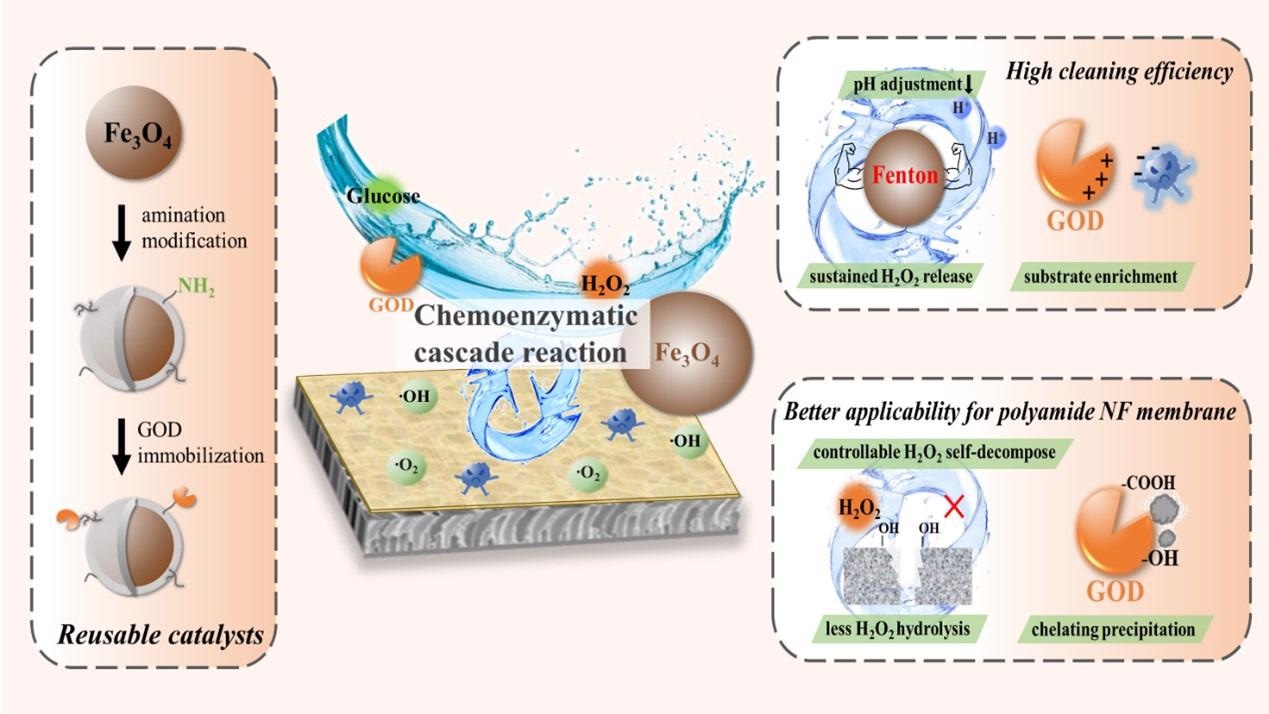A chemoenzymatic cascade reaction for green cleaning of polyamide nanofiltration membranes has been suggested by a research team headed by Professor Yinhua Wan from the Institute of Process Engineering (IPE) of the Chinese Academy of Sciences.
 Preparation of reusable catalysts and schematics of the chemoenzymatic cascade reaction for cleaning polyamide NF membranes. Image Credit: Jinxuan Zhang.
Preparation of reusable catalysts and schematics of the chemoenzymatic cascade reaction for cleaning polyamide NF membranes. Image Credit: Jinxuan Zhang.
The study was reported on March 2nd, 2022, in the journal ACS Applied Materials & Interfaces.
In wastewater treatment and product purification, chemical cleaning is considered to be vital for the sustainable operation of nanofiltration (NF). But common chemical cleaning techniques are plagued by high chemical consumption, low cleaning efficiency and worsening membrane separation performance.
The Fenton reaction is anticipated to be a hopeful method for highly effective membrane cleaning as a result of its exceptional oxidation capability. However, a Fenton cleaning plan needs a high concentration of hydrogen peroxide (H2O2) and an acidic environment.
This causes damage to the polyamide separation layer as well as heavy acid reagent consumption. At the same time, the transportation and storage of H2O2 are expensive and very risky.
In our proposed cascade reaction, a glucose oxidase (GOD) enzymatic reaction produces H2O2 and gluconic acid to trigger the oxidation of foulants by a Fe3O4-catalyzed Fenton reaction.
Yinhua Wan, Professor, Institute of Process Engineering, Chinese Academy of Sciences
The scientists discovered that this chemoenzymatic cascade reaction (GOD- Fe3O4) showed highly favorable degradation efficiency compared to a single Fenton reaction, by benefiting from microenvironmental (that is, pH and H2O2 concentration) engineering and substrate enrichment.
As a result of the powerful oxidative degradation, the water flux of the NF10 membrane fouled by methyl blue was almost completely restored (~95.8%) following three cycles of fouling or cleaning experiments.
In-situ production and instant consumption of H2O2 in the cascade reaction protected membranes from being harmed by a high concentration of H2O2. At the same time, GOD biomolecules in the cascade system restrained secondary fouling by ferric hydroxide precipitates. Hence, the polyamide NF membrane showed powerful tolerance to the chemoenzymatic cascade reaction.
Furthermore, the scientists made a reusable cleaning agent by immobilizing GOD on the aminated Fe3O4 nanoparticles to enhance the sustainability of this cleaning strategy. The prepared catalysts (GOD-Fe3O4) showed stable degradation efficiency and a favorable cleaning effect with repeated use on exposure to an external magnetic field.
This chemoenzymatic cascade reaction without addition of acid/base/oxidant provides a promising candidate for sustainable and cost-effective cleaning for polyamide NF membranes. It also offers a feasible approach for optimizing the Fenton cleaning strategy.
Jianquan Luo, Study Corresponding Author and Professor, Institute of Process Engineering, Chinese Academy of Sciences
Journal Reference:
Zhang, J., et al. (2022) Chemoenzymatic Cascade Reaction for Green Cleaning of Polyamide Nanofiltration Membrane. ACS Applied Materials & Interfaces. doi.org/10.1021/acsami.1c23466